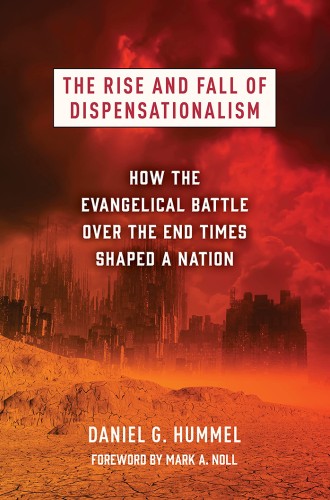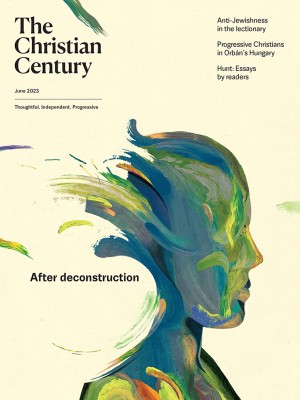The rapture and beyond
Daniel Hummel shows how deeply dispensationalism has shaped American religion.
Evangelicals in the 20th and 21st centuries have continually had to reckon with the culture of dispensationalism. Popular dispensationalism, with its hyper-fixation on the end times, has shaped the religious right since its inception in the late 1970s. As a child attending an evangelical church in the Left Behind era, I often heard preaching about the rapture or the coming of the Antichrist. Christian media have been replete with themes of the end times, from books on prophecy fulfillment to songs about being left behind.
More recently, the “Snapture” in Marvel’s 2018 blockbuster Avengers: Infinity War—a scene in which a character’s snap of the fingers causes half the world’s population to instantly dissolve into dust—brought dispensationalism back into mainstream culture. In most of these cases, the rapture appears in isolation from other critical components of dispensationalism, which include God’s covenants with humanity during various dispensations of history and separatism between the church and the world.
Read our latest issue or browse back issues.
Dispensationalism is a form of premillennialism, the belief that Christ will return to earth before the millennium spoken of in Revelation 20 occurs. In dispensationalism, the millennium is the final dispensation of history, after which time will come to an end; presently history is in the dispensation known as the church age. The Bible has foretold that throughout the church age, society will continually deteriorate until the rapture, after which God’s judgment will descend in the seven-year tribulation and the terrifying reign of the Antichrist. Following the tribulation, Christ will return to earth and defeat the Antichrist before beginning his 1,000-year reign from the throne of David in Jerusalem.
In his 1980 landmark study, Fundamentalism and American Culture, George Marsden declared, “It is doubtful that premillennialism was really the organizing principle” of fundamentalism. At the very moment when popular dispensationalists—Jerry Falwell and Tim LaHaye top the list—were organizing a voting bloc of conservative Christians, scholars influenced by Marsden were moving away from understanding dispensationalism. With Falwell preaching in front of state capitol buildings, conversing regularly with President Reagan, and appearing on CNN, the stakes of Marsden’s dismissal of premillennialism were high.
Thus, The Rise and Fall of Dispensationalism is long overdue. Daniel Hummel explains in great detail and with great clarity the forces that have shaped dispensationalism, leading up to the rise of the religious right and beyond. He helps readers understand what dispensationalism is while dispelling myths that have stymied research into dispensationalism as a potent force in American public life. These myths include the idea that dispensationalism is not a critical component of Protestant fundamentalism in America; that it is, first and foremost, an eschatological system; that it is the natural outcome of a plain-text reading of the Bible; that it is primarily a southern phenomenon; and that it is a monolithic system that lacks diversity. Hummel presents a solid framework for understanding what dispensationalism really is, how it has influenced American fundamentalism, and how it shapes broader American culture.
In the process, he ably corrects Marsden’s error by showing that the premillennial hermeneutic that became dispensationalism served as a solvent for other cultural forces that also shaped Protestant fundamentalism. There certainly were elements involved in the shaping of fundamentalism that went beyond the millenarianism of the post–Civil War years: the story of millenarianism in America includes an apocalyptic strand among some Puritans, the Millerite movement of the 1840s, and the holiness movement. Other elements that are of distinctly British origin and crossed the Atlantic include Scottish common sense realism, John Nelson Darby’s foundational teachings, and Plymouth Brethren theology. Showing that all of these components became wrapped into the “new premillennialism,” Hummel consistently makes the point that dispensationalism does, and has since the 19th century, matter.
None of these elements was sufficient on its own to give rise to what is today generally called dispensationalism. Taken together in an American context, however, the hermeneutic of dispensationalism became both a scholarly pursuit and a pop culture phenomenon. Hummel examines both scholarly and popular approaches to dispensationalism, carefully showing that Falwell and LaHaye taught a different dispensationalism than the likes of James Hall Brookes (mentor of C. I. Scofield, editor of the Scofield Reference Bible) and Lewis Sperry Chafer (protégé of Scofield and cofounder of Dallas Theological Seminary). This distinction is essential, as few scholarly critiques of dispensationalism have arisen since the organizing of the religious right.
The Rise and Fall of Dispensationalism is certainly a historical analysis and critique. But it offers something more to evangelicals and exvangelicals whose churches were inundated with the pop theology of Left Behind: sound answers to questions we may not have realized we had. Hummel gives readers like me the ability to discern the more destructive elements of pop dispensationalism while recognizing the hermeneutic’s place in a long history of American evangelicalism. Evangelicalism predates and will postdate dispensationalism, but dispensationalism’s imprint is present and will remain for the foreseeable future.






